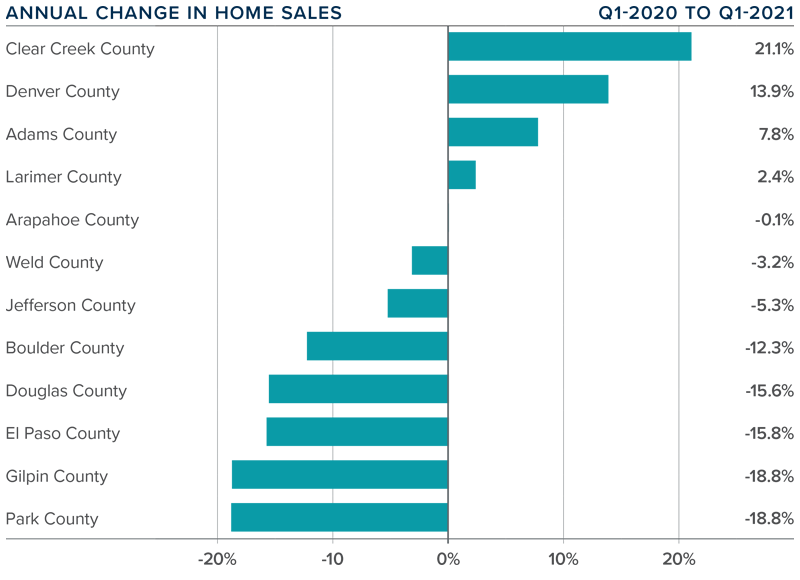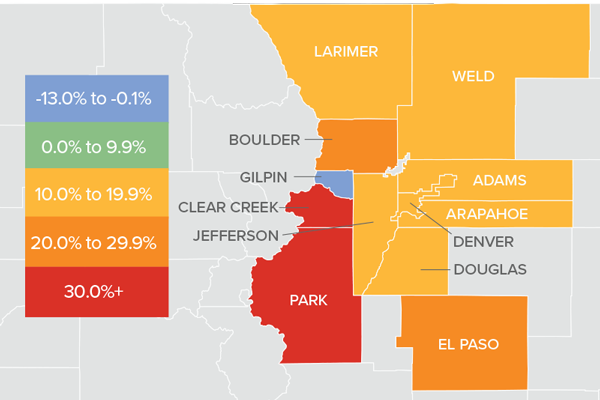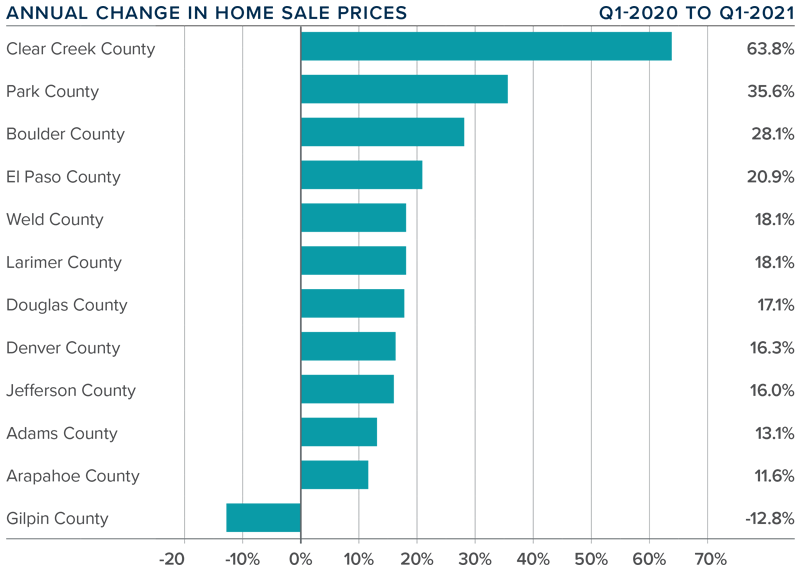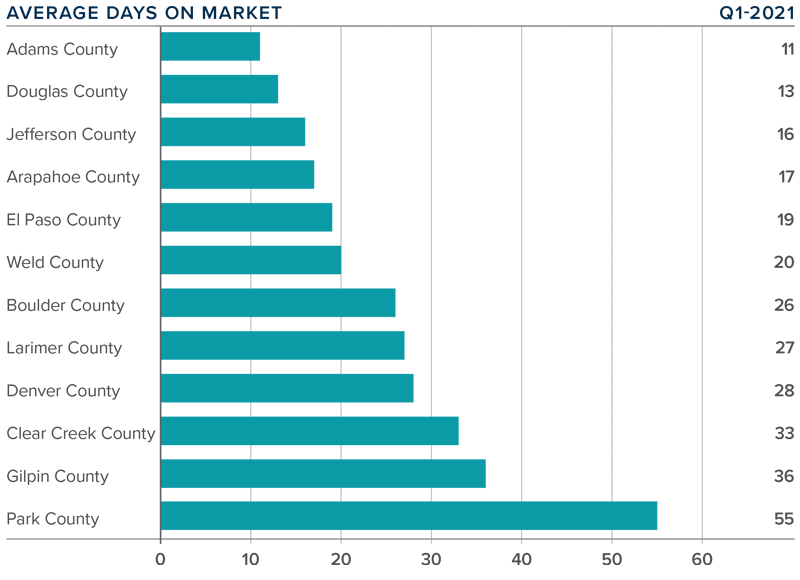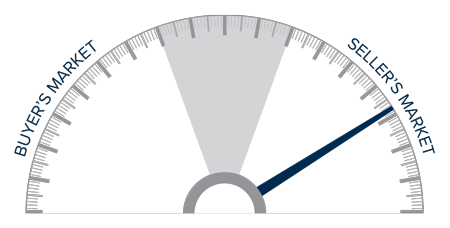What Gives?


“I thought the market was cooling off, so why are prices still going up?”
This is a frequent question we hear from our clients.
They are understandably confused by the fact that average prices have continued to rise at a rapid pace even though sales activity is slower than what it was 6 months ago.
Bottom line, they want to know why prices are up along the Front Range anywhere from 12% to 17% compared to last year.
Firstly, we don’t expect this pace of price appreciation to continue. What we foresee is price growth going back to the long term average of 5% to 6% per year.
The reason why we still see double-digit growth comes down to two words. Supply and Demand.
Supply, while higher than a year ago, is still relatively low.
Also, demand, while lower than a year ago, is still relatively high.
The market is still healthy, just not as frantic as it was.
Properties are still selling, but bidding wars and multiple offers have mostly gone away.
Sellers remain in a strong position, but they face more competition than before.
Average Prices

It’s true, average prices have increased substantially over the last year.
Would you have guessed that Weld County has seen the largest increase along the Front Range?
The specific numbers are below.
As you look at the numbers, it is important to remember that average prices have increased because of appreciation and because there are more higher-end homes that are selling.
The increased volume of high-end transactions has played a big rule in increasing the average price.
Average Price of a Single-Family Home based on closings so far this month:
- Metro Denver = $675,000
- Larimer County = $624,000
- Weld County = $514,000
Average Prices exactly one year ago:
- Metro Denver = $614,000
- Larimer County = $549,000
- Weld County = $417,000
In Perspective

Let’s put today’s home prices in perspective.
Appreciation has been significant over the last 18 months. Some people are wondering if it can last and if there might be a housing bubble.
There are two ways to look at prices. One way is in absolute terms. This is simply looking at the dollar amount a home would sell for at some point in the past versus the dollar amount it would sell for.
The other way is in real terms. ‘Real’ is an economics term which means that inflation is factored into the valuation.
For example, a gallon of milk costs more today in absolute terms than it did 15 years ago. However, in real terms, the cost is about the same as 15 years ago because inflation is factored in. The price of milk has essentially escalated at the same rate as inflation.
So, how about home prices? As we know, prices in absolute terms are higher than 15 years ago. To be exact, prices are 43% higher Nationally compared to 2006 according to Case-Shiller.
However, in real terms, prices are the same as 2006.
Over the last 15 years, homes have appreciated at essentially the same rate as inflation.
Drastically Different

Recently it seems there are many attempted comparisons being made between today’s real estate market and the 2006-2007 market.
It seems that people fear a repeat of what happened to the market in 2008 and 2009.
Buyers, understandably, want to make smart decisions and don’t want to buy in advance of any downturn.
The reality is this. There are some similarities between now and the pre-bubble market of 15 years ago. Namely, prices are appreciating quickly.
However, there is one massive difference.
The inventory of homes for sale right now is drastically different than 15 years ago.
The rules of economics tell us that, in order for prices to crash, demand needs to diminish, supply needs to swell, or some combination of the two.
Here’s the deal. Supply today is a fraction of what is was 15 years ago.
Homes for sale today:
- Larimer County = 238
- Weld County = 226
- Metro Denver = 2,594
Homes for sale 15 years ago:
- Larimer County = 2,998
- Weld County = 1,113
- Metro Denver = 29,045
The reason why prices flattened and decreased slightly along the Front Range in 2009 is because the National economy had a meltdown and there was a glut of supply.
We do not have anything similar to those same dynamics today.
We are watching the market closely every single day. While we don’t expect the current pace of appreciation to keep up, we believe inventory levels keep us insulated from any kind of crash.
Q1 2021 Colorado Real Estate Market Update

The following analysis of the Metro Denver & Northern Colorado real estate market is provided by Windermere Real Estate Chief Economist Matthew Gardner. We hope that this information may assist you with making better-informed real estate decisions. For further information about the housing market in your area, please don’t hesitate to contact your Windermere Real Estate agent.
REGIONAL ECONOMIC OVERVIEW
Following the decline in employment last winter, Colorado has started to add jobs back into its economy. The latest data shows that the state has now recovered more than 219,000 of the 376,000+ jobs that were lost due to COVID-19. This is certainly positive, but there is a long way to go to get back to pre-pandemic employment levels. Denver and Fort Collins continue to have the greatest improvement in employment, but all markets show job levels well below pre-pandemic levels. With total employment levels rising, the unemployment rate stands at 6.6%, down from the pandemic peak of 12.1%. Regionally, unemployment levels range from a low of 5.6% in Fort Collins and Boulder to a high of 6.7% in Greeley. COVID-19 infection rates have started to increase again, and this has the potential to negatively impact the job market. I am hopeful that the state will not be forced to pull back reopening, but this is certainly not assured.
COLORADO HOME SALES
❱ 2021 started off on a bit of a sour note, with total sales down 1.2% compared to the same period in 2020. Sales were 29.2% lower than in the final quarter of 2020 as 8,645 homes sold.
❱ Sales were higher in four of the counties contained in this report, were essentially flat in one, and dropped in seven. It was pleasing to see significant sales growth in the large counties of Denver and Adams.
❱ Another positive was that pending sales, which are an indicator of future closings, were 4.8% higher than in the fourth quarter of 2020 and 5% higher than a year ago.
❱ The disappointing number of home sales overall can primarily be attributed to the woeful lack of inventory. Listings in the quarter were down more than 61% year over year and were 40.6% lower than in the fourth quarter of 2020.
COLORADO HOME PRICES
❱ Prices continue to appreciate at a very rapid pace, with the average sale price up 16.5% year over year, to an average of $556,100. Home prices were also 4.4% higher than in the fourth quarter of 2020.
❱ Buyers appear to be out in force, and this demand—in concert with very low levels of inventory—continues to heat the market.
❱ Prices rose over last year across all markets covered by this report, with the exception of the very small Gilpin County. All other counties saw sizeable gains and the trend of double-digit price growth continued unabated.
❱ Affordability levels are becoming a greater concern as prices rise at a far faster pace than wages. Even though mortgage rates have started to rise, they haven’t yet reached the level needed to take some of the heat out of the market.
DAYS ON MARKET
❱ The average time it took to sell a home in the markets contained in this report dropped 20 days compared to the first quarter of 2020.
❱ The amount of time it took to sell a home dropped in every county contained in this report compared to the fourth quarter of 2020.
❱ It took an average of 25 days to sell a home in the region, down one day from the fourth quarter of 2020.
❱ The Colorado housing market remains very tight, as demonstrated by the fact that it took less than a month for homes to sell in all but two counties.
CONCLUSIONS
This speedometer reflects the state of the region’s real estate market using housing inventory, price gains, home sales, interest rates, and larger economic factors.
The relatively low level of home sales is not a surprise given how few choices there are for buyers. Sellers are certainly benefitting from strong demand, as demonstrated by the significant price growth. I maintain my belief that there will be an increase in inventory as we move through the year, but it is highly unlikely that we will see a balanced market in 2021.
Given these factors, I am moving the needle a little more in favor of sellers, as demand is likely to continue to exceed supply.
ABOUT MATTHEW GARDNER
As Chief Economist for Windermere Real Estate, Matthew Gardner is responsible for analyzing and interpreting economic data and its impact on the real estate market on both a local and national level. Matthew has over 30 years of professional experience both in the U.S. and U.K.
In addition to his day-to-day responsibilities, Matthew sits on the Washington State Governors Council of Economic Advisors; chairs the Board of Trustees at the Washington Center for Real Estate Research at the University of Washington; and is an Advisory Board Member at the Runstad Center for Real Estate Studies at the University of Washington where he also lectures in real estate economics.
Re Bubble

The activity in the Front Range market is causing us to hear the bubble question again.
People are curious to know, based on recent growth in price appreciation, if we are in a housing bubble.
This question seems to crop up when prices go up.
While we do not believe that the current double-digit price appreciation is sustainable, we firmly believe we will not see prices crash or see any kind of a bubble bursting.
Here’s why we think that…
This past Tuesday we hosted a private online event for our clients which featured our Chief Economist Matthew Gardner.
Matthew is well-known and well-respected in the industry. He is often quoted in leading real estate publications.
He sees four reasons why there is no real estate bubble that is about to pop in Colorado.
- Inventory is (incredibly) low. The number of homes for sale is down over 40% compared to last year. The market is drastically under-supplied. Based on simple economic principles of supply and demand, inventory would need to grow significantly for prices to drop.
- Buyers’ credit scores are very high. The average credit score for buyers last month, for example was 759. So, by definition, average buyers today have excellent credit which means there is low risk of them walking away from their mortgage and causing a foreclosure crisis.
- Buyers have high down payments. On average, buyers are putting 18% down on their purchases. This means that prices would need to fall by a considerable amount in order for the average buyer to be ‘upside down’ on their mortgage.
- Owners are equity rich. Well over a third of property owners along the Front Range have more than 50% equity in their homes. This means that a severe economic downturn causing a slew of distressed properties to hit the market is highly unlikely.
Bottom line, as Matthew Gardner reminded us, what we are experiencing in the economy today is a health crisis not a housing crisis.
If you would like a recording of the private webinar we would be happy to send it to you. Just reach out and let us know.
 Facebook
Facebook
 X
X
 Pinterest
Pinterest
 Copy Link
Copy Link
